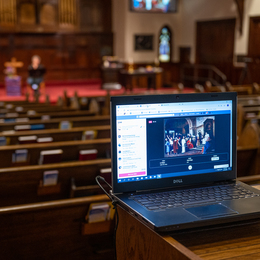
Relying on Faith
In this time of social distancing, local religious communities are finding unique ways to strengthen their spiritual bond.
Often, in times of uncertainty and anxiety, people turn toward their faith for guidance. Whether it be attending services with fellow members or speaking directly with a religious leader, both bring a sense of comfort to many in our area. But since houses of worship have been shuttered due to the pandemic, members of various local religious communities have scrambled to find ways to stay connected when they need it most.
In-person services became virtual services online; Bible studies and other weekly get-togethers took place on Zoom. Despite the challenge of taking something that is very communal and adapting it in this time of social distancing, spiritual groups across South Jersey have used these past few months to strengthen their bonds and deepen their beliefs.
Monsignor Louis Marucci at St. Andrew the Apostle Church in Gibbsboro understandably had a few concerns right away, and the first thing his staff addressed was to make sure the church remained connected to its parishioners. He tasked the entire parish staff, while they worked from home, to develop ways they can provide ongoing connection to the parishioners, particularly through the use of technology.
“Since we cannot determine what the ‘new norm’ might be, I have required the staff to establish a two-fold method for ongoing ministry,” he says. “The first that plans with people physically present, yet incorporates the safety requirements to protect staff and parishioners; the second to develop ministry plans using technology as we continue to find ways to maintain regular connection to the congregation.”
Rabbi Benjamin David of Adath Emnau-El in Mount Laurel wanted to make sure that he still provided a comforting place for his vulnerable population.
“For me, especially going to a pastoral place with regard to reaching out to our more vulnerable population and those that are elderly, responding to widespread fear and anxiety and having the synagogue be a place of comfort and reassurance in a time that felt incredibly unnerving and uncertain was important,” says David. “In some ways, everything changed overnight, but I think our tradition and heritage has always prepared us for this kind of moment in that part of what it means to be part of a community of faith is to respond to those in need and be there for those who are unsure, and that’s what we did.”
Going Virtual
While some places of worship already offered live-streaming services, for those that didn’t, religious leaders suddenly had to become tech geniuses.
“How to make virtual services work in three days was a stressor,” says Ben Maddison, rector of Holy Trinity Episcopal Church in Wenonah. “I am deeply thankful I am one of the few millennial digital native clergy in the diocese. The fact that I knew how to use Facebook live and work Zoom; all of that made it much easier.”
“We hadn’t done virtual services prior to all of this, but I think a lot of us found great meaning and comfort in virtual services, even if they felt different,” David adds.
“It fills the need,” says Brian Sattinger, member and past president of Adath Emanu-El. “It’s not the same as being able to see them but it definitely fills a gap. It’s nice to see everybody can participate and we can all be connected that way.”
And the high numbers of those attending these online services has spiked. In January, St. Andrew’s had 854 online viewers compared to the more than 15,000 it saw in March.
“The blessings of virtual worship, if there are any, is that we have seen a significant increase in attendance,” Maddison says. “The more folks I talk to ... they really feel they are being connected when they are disconnected physically. Those are great things.”
Matthew Baer, a member of Fellowship Alliance Chapel in Medford, says he always had been a faithful person, but after he was furloughed from his job, he relied heavily on the church.
“I was pretty scared and wasn’t sure what [was] going to happen,” he recalls. “I told myself I need to get back stronger in my faith and work through things that way and I feel like I’m in a better spot spiritually than I was before the pandemic.”
Places of worship are also finding ways to keep connected to their members in addition to streaming weekly services, from calling members frequently to make sure they aren’t feeling socially isolated, holding virtual Bible study and other group discussions as well as increasing social media presence by posting uplifting videos throughout the week.
“In some ways this has helped strengthen my faith because before that, it was just connecting with my church every Sunday,” Baer says.
Transitioning
Starting a new job in the middle of a pandemic, especially in a place of worship, may seem daunting to some. But for Nikki Passante, who came onboard as associate pastor at First Presbyterian Church Haddonfield on April 5, “it made perfect sense.”
“God has dealt with me in a funny way,” she says. “I’ve always come into job situations where something is going on. This is only my third church and each time the church has been in a major transition. So the fact that [former pastor] Bill Getman was already leaving prepared me for the pandemic. I was fortunate that when I came on, our church was already live-streaming services. I didn’t have to do what a lot of other ministers had to do, which was learn technology. Instead of being a pastor, some have to be a producer.”
That doesn’t mean performing services hasn’t come with its challenges. “The first few Sundays I did not mind preaching to an empty sanctuary, I just pretended the entire congregation was in the camera lens. But as the weeks progressed it’s gotten hard and exhausting because the sermon is more than a lecture,” Passante says.
It was taking a toll on Maddison as well, and he became exhausted mentally and emotionally.
“I can’t take [Holy] Communion to anyone, I can’t visit anyone in the hospital, the only thing I can do is check in and see how people are doing. That was heavy,” he says. “I can’t tell you the number of times I would come home from live streaming the service and cry because this is not how I want to do church. All of this is way more difficult than it looks.”
Abigail Walsh was also in transition with jobs within the past month. She was the music director at St. Joachim Parish in Bellmawr until the end of June before becoming the pastoral assistant at St. Andrew’s July 1. Not being able to say goodbye in a “normal” way made it very difficult for the Voorhees resident.
“[When the announcemtn was made] I would be leaving, it was hard to see people’s reaction,” Walsh recalls. “We couldn’t give hugs or hold hands and I think that made it more emotional and more difficult. It didn’t feel like a finalized goodbye. As humans, we’re so used to that interaction especially within church communities.”
Reconnecting
Since Gov. Murphy lifted restrictions on indoor gatherings in the middle of June, places of worship are allowed to have up to 100 people or 25 percent of the capacity—whichever number is lower.
Walsh went to service the first week St. Joachim re-opened with excitement, thinking it would be exactly what it was like pre-quarantine.
“In actuality, upon arriving, not many people came and I felt like my bubble burst a bit,” she recalls. “In my mind I was expecting a homecoming and it wasn’t quite like that. Being at mass post-quarantine is strange because everyone has to wear masks, and as a singer at the mass, you’re looking out and can’t see expressions.
“There’s hand sanitizer when you walk in and signs that say mandatory masked zone. Pews are marked where you are allowed to sit and not sit; there are sections for families, couples and single people to keep everyone socially distant.”
St. Andrew’s opened with a limited schedule, with three masses weekly and parishioners must register online to assure the church is not exceeding the seating capacity, according to Marucci.
“Currently, we can hold approximately 100 people in the church, following physical distance guidelines, but we also stream the service into our parish hall where another 100 parishioners can be seated,” he says. “I am only seeing small numbers in comparison to previous attendance. We get anywhere between 40-90 people at any scheduled mass. I believe people are waiting to see if there will be another spike and are simply protecting their families, which I believe is the appropriate thing to do at this time.”
Similar to St. Joachim, parishioners must wear a mask, they are screened for a fever prior to entering the church, must use hand sanitizer when entering and exiting, pick up their own bulletin and follow diagrams to sit in special designated areas divided for families, couples and individuals.
Fellowship Alliance Chapel reopened for outdoor services mid-June in their parking lot and Baer has been going to service just about every week. Everyone has to bring their own chair, members are asked to wear masks and socially distance as much as possible. As of a few weeks ago, Baer estimated there were a few hundred people attending the outdoor service.
“The second week they had cones every eight to 10 feet apart marking where people should be and made announcements asking people to be respectful of personal space,” he says. “They have done a good job at making everyone feel comfortable.”
Re-opening also comes at a cost, between getting access to cleaning supplies and the high price of making sure each building is cleaned to CDC standards is burdensome.
“My estimation is it will cost an extra $5,000 to $7,000 to get our church as clean as we need it to be, and that is over and above all the changes to the service we’ve made,” Maddison says.
But not every place of worship is ready to open their doors, even with limited capacity. Adath Emanu-El has no plans to open for the foreseeable future.
“Our feeling from the beginning has been, just because we can, doesn’t mean we should,” David says. “Even if we’re allowed to have a small number in the sanctuary at this time, we only want to do that when we feel really confident it’s appropriate. We will aim to do a few socially distant outdoor services this summer with everyone wearing masks with the hope we can at least feel each other and feel the presence of the community.”
First Presbyerian Church Haddonfield has a similar frame of mind and is acting in the best interest of its members, especially the elderly and children, and does not plan to gradually open anytime soon.
“We’re not going to return to worship until everyone can,” Passante says. “We’re not doing a phase one reopening where only a certain number of families can be in the congregation. We’re planning on not being in the sanctuary for another year. It will most likely be next June before we worship together.
“I’d love to get people’s focus from let’s go back to normal to how can we expand on what’s working really well? We want to be available to people. It’s about making things easier to enter into. We’re not a gatekeeping community, we’re an opening and welcoming community online and are open to whoever feels like logging on. When we go back to in-person worship we will have a larger community and we’ll have a much bigger picture of who and what the church is.”
Click here to subscribe to the free digital editions of South Jersey Magazine.
To read the digital edition of South Jersey Magazine, click here.
Published and copyrighted in South Jersey Magazine, Volume 17, Issue 4 (July 2020).
For more info on South Jersey Magazine, click here.
To subscribe to South Jersey Magazine, click here.
To advertise in South Jersey Magazine, click here.
Click here to subscribe to the free digital editions of South Jersey Magazine.
To read the digital edition of South Jersey Magazine, click here.
Published and copyrighted in South Jersey Magazine, Volume 17, Issue 4 (July 2020).
For more info on South Jersey Magazine, click here.
To subscribe to South Jersey Magazine, click here.
To advertise in South Jersey Magazine, click here.












